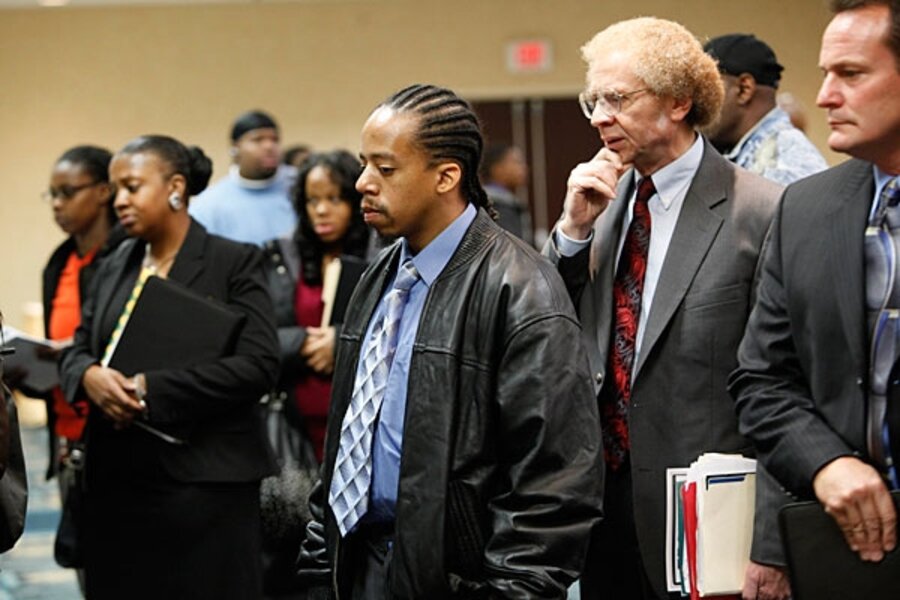Just 11,000 jobs lost in November: a sign of improved job market
Loading...
For the first time in two years, the US economy came tantalizingly close to posting a monthly gain in jobs.
Employer payrolls fell by just 11,000 workers in November, much less than economists expected, according to a Labor Department report Friday. Also, the unemployment rate fell modestly, from 10.2 to 10 percent.
Although the monthly numbers still show job declines rather than gains, the job market is moving convincingly in a positive direction.
The report suggests that net gains in jobs might begin in the next few months or even weeks.
At a time of high unemployment and consumer pessimism, it raises the question: Could a jobs recovery gather momentum faster than most forecasters expect? Could it even become what's known as a "V"-shaped recovery in jobs – with the gains coming out of recession mirroring the scale and pace of the losses during the recession?
Many economists, after all, had been expecting about 125,000 jobs lost for the month.
"This was the best jobs report, payrolls-wise, since December 2007," says Ken Mayland, president of the research firm ClearView Economics near Cleveland. "It says that job gains are in sight pretty quickly."
Most economists bullish on job growth for 2010
Some forecasters, in fact, expect something akin to a V-shape jobs recovery in the next year.
Mr. Mayland sees the economy adding about 1.5 million jobs next year, a decent pace but one that wouldn't fill much of the 7-million job hole created by the recession.
But in a November survey by the National Association for Business Economics, the five most optimistic forecasters projected job gains of nearly 3.5 million during 2010 – or nearly 300,000 per month. Those gains would be on par with what occurred during the economic recovery of the mid-1990s.
The consensus view, however, is closer to Mayland's forecast of about 100,000 job gains per month next year.
Whether the recovery in jobs ends up surprising on the up side or not, the latest Labor Department report lends support to the view that America won't experience a "jobless recovery" or a "job-loss recovery" (with the economy losing jobs even as gross domestic product expands).
Obama, in Allentown, Pa., cites 'good' trend line
"The trend line right now is good," President Obama said during a Friday visit to Allentown, Pa.
But with more than 15 million Americans unemployed, and young people entering the work force each year, the president was quick to add that a big challenge still lies ahead.
"We've got to actually grow jobs and get America back to work as quickly as we can," he told a town hall audience. He also sought to deflect criticism that his recent focus on healthcare reform is having a counterproductive effect on business hiring. The proposed reforms are "part of our jobs plan" and will make health insurance more accessible to small employers, Obama said.
After recessions in 1991 and 2001, America saw long periods of stagnant job growth. Employment actually kept falling for two years after the 2001 recession. This time, the problem is the unusually large number of unemployed people on the sidelines. Some forecasters warn that, though the economy could add 1 million jobs next year, the high unemployment rate may not come down very much.
Obama held a jobs summit Thursday in a quest for new policies to spur hiring. In his Friday remarks, he warned that there would be "gyrations" ahead as the job market recovers.
Better jobs numbers: more than a one-month wonder?
Still, economists generally greeted the Friday employment numbers as more than just a one-month anomaly.
They noted several important trends:
• The Labor Department revised its estimates of job losses in two prior months, showing a loss of 139,000 jobs in September (versus 219,000 reported earlier) and 111,000 jobs lost in October (down from 190,000 reported earlier).
• Temporary help services added 52,000 jobs in November. Often, the hiring of temp employees is a sign that businesses face rising demand that they can't meet with their existing work force. A rise in permanent hiring usually follows.
• The average work week for production and nonsupervisory workers in the private sector rose a bit, to 33.2 hours. That, too, is a sign of rising labor demand. And more work hours mean more wage income in American pockets.
----
See also:
Obama weighs using TARP bailout funds to spur job growth
Six ideas Obama heard at the White House jobs summit
----
Follow us on Twitter.





